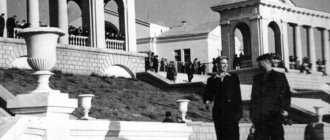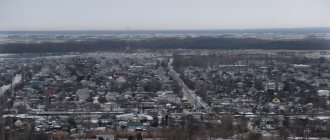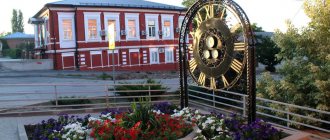The city with an area of 22.9 thousand hectares is located on the left bank of the Akhtuba River, 28.7 kilometers northeast of the center of Volgograd.
Volzhsky has a favorable geographical location - it is located at the intersection of international transport flows in the North-South and West-East directions. Water, railway and road transport routes converge here.
On the territory of the city and in its immediate vicinity, in the Volga-Akhtuba floodplain, which is called the pearl of the Volga region, there are dispensaries, recreation centers, children's health camps, tourist complexes, hunting grounds and picturesque fishing spots.
The basis of the city's economic potential is the enterprises of hydropower, metallurgy, mechanical engineering, and the chemical industry. 44 enterprises are leading. The total number of business entities in the city is more than 12 thousand, of which more than 10 thousand are small and medium-sized businesses.
The number of workers at large and medium-sized enterprises is about 60 thousand people, more than half of them are employed in industry.
The city has a diverse educational network. It has 88 municipal educational institutions of general, preschool and additional education, 5 higher educational institutions (1 of which is municipal), and three vocational education organizations. The education system of the city of Volzhsky is distinguished by its high quality, level of student achievement and professional success of teachers, which is confirmed by victories and prizes in regional and state olympiads and competitions at various levels. Since 2022, the city has fully ensured the availability of preschool education for all children aged one and a half to seven years.
Volzhsky has rich cultural traditions. Guests and residents of the city are received by 2 theaters (Volga Drama Theater and the Harlequin Puppet Theater), the Center for Culture and Art "October", the Palace of Culture "Volgoradgidrostroy", a museum and exhibition complex that unites 4 museums ("Historical and Local Lore Museum", " Exhibition Hall”, “Art Gallery”, “Museum of Memory of Soldiers of War and Law Enforcement”), 2 parks of culture and recreation (“Volzhsky” and “New City”), a municipal library network uniting 10 libraries. Various professional musical groups and creative associations work successfully, and bright concerts are given by an orchestra of Russian folk instruments, brass and symphony orchestras. The development of cultural life and art is facilitated by the activities of three music schools, two art schools, and an art school.
Conditions for the self-realization of young people, their civic, intellectual, creative and spiritual development are created by more than 50 youth and children's public associations and three municipal youth policy institutions (comprehensive youth, uniting fourteen teenage clubs, the Cascade teenage and youth complex, uniting four teenage -youth clubs, center for patriotic education of youth “Fatherland”).
More than 75 sports are being developed in the city district, there are more than 185 sports organizations, two sports schools, one of them is an Olympic reserve. Volga athletes take an active part, becoming winners and prize-winners in sports competitions at the interregional, all-Russian and international levels.
The development and popularization of physical culture and sports in the city is facilitated by the activities of the Volzhanin sports institutions, the Avangard, Rus and Voskhod sports and recreation complexes (Krasnooktyabrsky village).
The city's healthcare system is represented by 117 institutions, including 11 public and 106 private. Two public health institutions are of regional importance: the clinical perinatal center and the uronephrological center.
The number of social protection institutions is 6 units.
The leading sector of the economy is industry, which accounts for more than 94% of the production volumes of large and medium-sized enterprises. About 80% of the established industrial structure is occupied by manufacturing industries, among which two main industries dominate: metallurgy and chemical production.
The main metallurgy enterprises: Volzhsky Pipe Plant JSC (VTZ), which is the largest enterprise in the city with about 10 thousand employees, United LLC, PK DIA LLC, Volzhsky Pipe Profile LLC, ISOPAN RUS LLC, and other.
Among the leading chemical production enterprises: JSC Volzhsky Orgsintez, JSC TEKSKOR, LLC VZ, LLC Research and Production Enterprise "KF", LLC MBI Sintez. The rubber products of Voltair-Prom JSC, Volzhskrezinotekhnika JSC, Intov-Elast LLC, VRShRZ CJSC, Volgopromtrans LLC, Volzhskoye Enterprise of Rubber Products LLC and others are widely popular.
The main enterprises of mechanical engineering, equipment, including electronic and optical: JSC EPK Volzhsky, a branch of JSC EPK Samara in Volzhsky, JSC, NPP Meteor-Kurs LLC, Volgabas LLC, New Ton LLC and others.
In the construction industry, enterprises producing reinforced concrete products, abrasive tools, non-asbestos high-temperature fabrics, fiberglass reinforcement, reinforcing glass fabrics and meshes, paving slabs and other types operate effectively (JSC Volzhsky Abrasive, LLC Vati-auto, LLC GBZ- 1”, LLC “Energopromstroy”, LLC “StekloPlast” and others).
The food industry is also developed in the city. Everyone is well aware of the products of the JSC AB InBev Efes branch in Volzhsky, OJSC Volzhsky Bread Factory, JSC Molsyrkombinat-Volzhsky and others.
The main hydropower enterprise is a branch of PJSC RusHydro - Volzhskaya HPP, which is the largest hydroelectric power station in Europe and the Volga-Kama cascade with an installed capacity of 2.7 GW. and average annual electricity production of more than 11 billion kW/h. Other enterprises that support the livelihoods of the city's population and enterprises: LLC "Thermal Generation of the City of Volzhsky" (Volzhsky CHPP-1 and CHPP-2), MCP "Volzhsky Interdistrict Electric Networks", MUP "Vodokanal".
Under the influence of international sanctions and other factors, city enterprises adapt to the existing situation, find their niche and strengthen their positions in the domestic and foreign markets through modernization and technical re-equipment, participation in the processes of import substitution, development of new popular types of products and implementation of investment projects. City enterprises are also introducing technologies and implementing environmental measures aimed at protecting the environment and reducing negative impacts.
The quality of industrial products produced in the city district is annually confirmed by enterprises at various international and all-Russian exhibitions and competitions, which helps to establish new business connections, enter foreign markets, and increase exports. The largest exporting countries are the USA, Saudi Arabia, Egypt, Uzbekistan, Finland, Romania and other European countries. The city's industrialists are intensifying efforts to develop foreign trade relations with the countries of Central Asia, Africa, and South America.
In the urban district, the direction “Industrial tourism” is gaining popularity - organizing excursions to industrial enterprises in order to get acquainted with existing production facilities. Residents and guests of the city of Volzhsky have the opportunity to visit the production and get acquainted with the process and technology from personal experience, see high-tech equipment, expand information about the products produced and verify their quality.
In order to improve the environmental situation and reduce the negative impact on the environment, geochemical monitoring of the state of atmospheric air, water and soil is carried out. The work of stationary environmental control posts that continuously collect, process and store information about the state of the atmospheric air makes it possible to organize environmental protection measures and provide objective information about the state of the environment. The use of a mobile laboratory makes it possible to conduct observations at the borders of sanitary protection zones of industrial enterprises, in residential areas, at intersections, as well as near schools and kindergartens.
As part of the transition of the urban district - the city of Volzhsky to a new system of control in the field of ecology and improvement, the city territory (residential area) is divided into 12 districts. In each district, a public district council has been created and an inspector has been appointed to control the assigned territory.
Where is Volzhsky located?
Volzhsky is one of the largest industrial cities in the Lower Volga region, which forms the core of the Volgograd agglomeration and is located on the left bank of the Akhtuba River.
The distance from Volgograd is about 20 km (to the northeast). The city is connected to Volgograd by the Volzhskaya Hydroelectric Power Station dam. The approximate population is 327 thousand people. The total area of the city is 230 square kilometers. The climate in the city is temperate continental. The annual precipitation rate is 330 mm. A distinctive feature of the winter period in Volzhsky are sudden temperature changes. The city is divided into two parts: the old city - numbering is carried out by quarters; new city - numbering occurs by microdistricts.
The time zone of the city of Volzhsky is MSK+1, the offset relative to Coordinated Universal Time (UTC) is +4.
Emergence of the settlement
The exact number of development of the area has not been established. In all likelihood, it begins in the 14th century
V. In the Volga steppes there were at least several villages of the Golden Horde, as well as Nogais and Kalmyks. During the era of Peter the Great, Russian colonists explored the lower Volga, forcing the Kalmyk khans to move downstream to Akhtuba.
In the middle of the XVIII
V.
In these parts they were engaged in sericulture. Fugitive peasants willingly worked on mulberry plantations, acquiring the status of government workers. From 1766
to
1800
_
A silk production enterprise operated here. In the 17th
century in the southeast of the current area there was the village of Bezrodnoye. Thanks to the river flowing nearby, it was often called Upper Akhtuba.
Due to the favorable location, the number of residents is up to 1917
was approaching
2
tens of thousands. During the Battle of Stalingrad, it was completely destroyed by the Nazis, leaving no buildings, with the exception of a half-surviving school and mill.
Volzhsky Airport
The city of Volzhsky does not have its own airport. The nearest airfield is Volgograd International Airport “Gumrak”, which has the status of a federal facility. The distance from Volzhsky to Gumrak Airport is 38 km. The airfield was built on the basis of a former military airport.
The airport serves aircraft of major Russian airlines: Aeroflot, Utair, Nordwind Airlines, Pegas Fly, Azimut, Ural Airlines, Pobeda, S7 Airlines, Ellinair, Pegasus Airline. In the airport building, passengers have access to a VIP lounge, luggage storage, banks and ATMs, restaurants and cafes, shops, and additional luggage packing services. There is free Wi-Fi access. There is also a hotel located on the airport premises.
Volga Federal District
Volga Federal District (VFD) is a federal district in the European part of Russia; one of the nine federal districts of the Russian Federation. The administrative center is Nizhny Novgorod.
The district is located in the eastern part of the East European Plain, which is represented in this part by a combination of lowlands and large hills. In the east, the district is limited by the Middle and Southern Urals. The western slope of the Ural Mountains gradually decreases to the Russian Plain through low ridges and ridges with gentle slopes, and passes into the ridged and hilly elevated plains of the Cis-Urals. In the north of the district - Northern Uvaly, the watershed of the Volga and Northern Dvina basins. Along the right bank of the middle reaches of the Volga is the Volga Upland, in the south stretches the plateau-like General Syrt, the watershed of the rivers of the Volga and Ural basins.
The territory of the district is 1,036,975 km2, the population (as of January 1, 2022) is 29,673,644 people.
The Volga Federal District includes 6 Republics (Bashkortostan, Mari El, Mordovia, Tatarstan, Chuvash and Udmurt), 1 region (Perm) and 7 regions (Kirov, Nizhny Novgorod, Orenburg, Penza, Samara, Saratov and Ulyanovsk).
Surface water resources
The district's water resources are represented by a river network with a length of about 399.83 thousand km (the density of the river network is 0.39 km/km2), lakes and artificial reservoirs with an area of about 19.23 thousand km2 (lake density 1.85% - from 0.13% in the Kirov region to 7.11% in the Ulyanovsk region), swamps and wetlands with a total area of 13,559 km2 (swampiness 1.31% - from 0.12% in the Vologda region to 3.55% in Bashkiria). The Volga Federal District ranks third in terms of river network density after the Northwestern and Far Eastern Federal Districts.
The average long-term river flow is 271.3 km3/year. Surface water resources are distributed unevenly throughout the district; the Saratov region is most provided with river resources (241.5 km3/year), the least is the Republic of Mordovia (4.9 km3/year). In 2015, river flow in the Volga Federal District amounted to 253.2 km3/year, which is 6.67% lower than the long-term average. Below is the dynamics of river flow in the Volga Federal District from 2010 to 2015.
The Republics of Tatarstan and Mordovia became the most and least endowed with surface water resources in 2015 (214.2 km3/year and 3.8 km3/year, respectively). The change in water content in the regions of the district relative to the long-term average is different - from a decrease of 50.39% in the Orenburg region to an increase of 30.33% in Udmurtia. Below is the deviation of river flow in 2015 from the long-term average in all regions of the Volga Federal District.
On the territory of the Volga Federal District there is located most of the basin of one of the five largest rivers in Russia and the largest river in Europe - the Volga, in the east of the district there is part of the Ural basin, in the west, north and east there are small parts of the Don, Northern Dvina, Pechora and Ob basins, respectively. In addition to the Volga and the Urals, the large rivers of the federal district include: in the Volga basin - the Kama with its tributaries the Vyatka and the Belaya with its tributary the Ufa, the Oka with its tributary the Moksha and the Sura; in the Don basin - Khoper, in the Ob - Tobol basin.
The territory of the federal district contains most of the reservoirs of the Volga-Kama cascade - Gorkovskoye, Kuibyshevskoye, Saratovskoye and Cheboksary on the Volga and Kamskoye, Nizhnekamskoye and Votkinskoye on the Kama; large ones are also the Iriklinskoye reservoir in the Urals, Surskoye on Sura, Yumaguzinskoye on Belaya and Pavlovskoye on Ufa .
There are no large lakes on the territory of the district; the largest lakes are the lakes of the drainless regions of the Orenburg region - Shalkar-Ega-Kara and Aike, which strongly depend on the period of water availability.
In the Volga Federal District there are several irrigation and water supply systems, the largest main canals are the Saratov Canal named after. HER. Alekseevsky in the Saratov region and the unfinished Kuibyshevsky canal in the Samara region.
On the territory of the federal district there is a large swamp system included in the list of wetlands of international importance of the Ramsar Convention - the Kama-Bakalda group of swamps.
Groundwater resources
The forecast groundwater resources of the Volga Federal District are 84,738 thousand m3/day (9.74% of the total forecast groundwater resources in Russia). The largest volume of forecast resources is in Bashkiria (17,808 thousand m3/day - 21.02%), the smallest is in Chuvashia (630 thousand m3/day - less than 1%).
Groundwater reserves of the Volga Federal District as of January 1, 2015 amount to 16912.8 thousand m3/day, the degree of knowledge is about 20%. The underground resources of the Samara region are the most studied (53.19%), the least studied are the Penza region (4.93%).
According to data as of January 1, 2015, 4,615.7 thousand m3/day were produced and extracted from groundwater bodies of the Volga Federal District during the year, including 2,329 thousand m3/day from the fields. The highest figure is in Bashkiria (1107.5 thousand m3/day), the lowest is in Chuvashia (39.4 thousand m3/day). The degree of development of groundwater reserves in the Volga Federal District is 13.77%. The most developed underground water resources are in the Perm Territory (24.61%), the least - in the Saratov Region (1.39%).
Provision of population with water resources (according to 2015 data)
The provision of the district's population with river flow resources is 8.553 thousand m3/year per person, which is more than 3 times lower than the Russian average (31.717 thousand m3/year per person). The population of the Orenburg region is least provided with water resources (3.158 thousand m3/year per person), the most is the Ulyanovsk region (158.315 thousand m3/year per person).
The provision of predicted groundwater resources is 2.856 m3/day per person, which is almost 3 times less than the Russian average (5.94 m3/day per person). The lowest supply is in Chuvashia (0.509 m3/day per person), the highest in the Kirov region (6.483 m3/day per person). Below are the dynamics of the provision of the district's population with river flow resources in 2010–2015 and a comparison of the provision of river flow resources in 2015 in all regions of the Volga Federal District.
Water use (as of 2015)
The withdrawal of water resources from all types of natural sources in the Volga Federal District amounted to 8919.22 million m3. The largest intake is in the Perm Territory (1992.47 million m3), the smallest is in the Republic of Mordovia (56.87 million m3). Most of the water was taken from surface water sources - 7365.65 million m3 (82.58%), which is about 2.9% of the river flow resources of the federal district. Below is the dynamics of fresh water intake in the Volga Federal District in 2010–2015 and a comparison of fresh water intake in 2015 in all regions of the Volga Federal District.
The total water losses during transportation in the regions of the Volga Federal District amounted to 483.1 million m3 or 5.42% of the withdrawn water; the largest water losses are recorded in the Penza region (12.16%), the smallest in the Kirov region (1.46%). Below is the dynamics of water losses during transportation in the Volga Federal District in 2010–2015 and a comparison of water losses during transportation in 2015 in all regions of the Volga Federal District.
Direct-flow water consumption is 7781.85 million m3, from 52.58 million m3 in Mordovia to 1935.79 million m3 in the Perm region. Most of the water was used for industrial, as well as drinking and domestic needs (68.58% and 20.53%, respectively), irrigation and agricultural water supply account for 1.94% and 0.54%, respectively. The largest share of industrial water supply is in the Perm region (91.94%), drinking and household water supply is in Mordovia (66.49%), agricultural water supply is also in Mordovia (4.66%), water use for irrigation is in Saratov region (17.41%). Below is the dynamics of water consumption in the Volga Federal District in 2010–2015 and a comparison of water consumption in 2015 in all regions of the Volga Federal District.
Domestic water consumption per capita in the federal district is 53.841 m3/year per person (the Russian average is 56.205 m3/year per person) - from 37.521 m3/year per person in Chuvashia and up to 84.555 m3/year per person in the Samara region. Below is the dynamics of household water consumption per capita in the Volga Federal District in 2010–2015 and a comparison of household water consumption per capita in 2015 in all regions of the Volga Federal District.
The volume of circulating and re-sequential water consumption in the district is 27,858.81 million m3 or 78.17% of the total water consumption of the district. The most active use of "turnover" is in the Saratov region (93.71%), the least active - in the Penza region (30.37%). Below is the dynamics of direct-flow and recycling and re-sequential water consumption in the Volga Federal District in 2010–2015 and a comparison of direct-flow and circulating and re-sequential water consumption in 2015 in all regions of the Volga Federal District.
Discharge of wastewater into water bodies of the Volga Federal District is 6650.82 million m3, of which 62.17% is conditionally pure and normatively treated wastewater and 37.83% is polluted and insufficiently treated. The main polluters of the district are the Nizhny Novgorod region, the Perm region and the Republic of Tatarstan, discharging 15.48%, 15.22% and 15.2% of all polluted and insufficiently treated wastewater of the federal district, respectively. The water bodies of the federal district receive 17.45% of polluted and insufficiently treated wastewater in Russia - the third figure after the Central and Northwestern federal districts. Below is the dynamics of water disposal in the Volga Federal District in 2010–2015 and a comparison of water disposal in 2015 in all regions of the Volga Federal District.
Water quality (based on 2014 data)
In 2014, in the centralized water supply systems of the Volga Federal District, non-compliance with standards for sanitary and chemical indicators was recorded in 12.3% of samples taken, and for microbiological indicators - in 3.6% of samples. In non-centralized water supply systems, the quality of 27.3% of samples for sanitary-chemical indicators and 15.7% of samples for microbiological indicators did not meet the standard. Below is the dynamics of the corresponding indicators in the Volga Federal District in 2010–2014.
When preparing the material, we used data from the State reports “On the state and protection of the environment of the Russian Federation in 2015”, “On the state and use of water resources of the Russian Federation in 2015”, “On the state and use of land in the Russian Federation in 2015”, collection “Regions of Russia. Socio-economic indicators. 2016". The rankings of regions for surface and underground water resources do not take into account the indicators of federal cities - Moscow, St. Petersburg and Sevastopol.
Train Station
Volzhsky station is a railway station of the Volgograd branch of the Volga Railway. The station is located at st. Kirova, 19a. The opening date of the railway station is August 1964, the number of platforms is 2, the operating mode is 24 hours a day.
Popular long-distance train routes: Astrakhan, Grozny, Moscow, Baku, Dushanbe, Tashkent, Kyiv, Khujand, Grozny, Kulyab. In the summer, trains pass through the railway station in the following directions: Orsk, Novokuznetsk.
Volzhsky bus stations
The bus station in the city of Volzhsky is located at st. Kirova, 19G. The bus station building is located next to the railway station building, near the fast food chain “Aik Bistro”. The bus station's operating hours are from 6:00 to 22:00, every day, without long technical breaks. The bus station has seven platforms: one is used by city buses; three - suburban routes; three more are intercity.
The most popular regular bus routes: Balashov, St. Petersburg, Astrakhan, Volgograd, Arkhipo-Osipovka, Voronezh, Volgodonsk, Elan, Moscow, Nikolaevsk, Saransk, Sevastopol, Elton.
What is Volzhsky famous for?
First of all, the city of Volzhsky is known for its hydroelectric power station. The construction of the hydroelectric power station was completed in 1961. Now the hydroelectric power station provides electricity to the Western and Central regions of Russia.
Also in the city is the Gidrostroitel park, founded in 1951. The park is located in the central part of the city; the total area is 14 hectares. Among the existing monuments in the city, it is necessary to highlight the War Memorial. The monument is the personification of grief and faith, which helped defeat enemies during the Great Patriotic War.
In 1911, a mill was built on the territory of the city, where repair bases, headquarters and artillery regiments were located during the Great Patriotic War. Flour was also produced here during the war.
In the central part of the city there is the October House of Culture, which was built in 1977. The cultural center received the name "October" later - in 1994. Next to Lenin Square there is an exhibition hall named after G.V. Chernoskutov, named after the Honored Artist of the Russian Federation. Art exhibitions are held here, photographs and works of young artists are exhibited.
Not far from Lenin Avenue is Fontannaya Street. The street begins with a small alley with fountains. Also on the street there is a monument to the first builders of the hydroelectric power station, a local history museum, and a registry office.
Nizhny Novgorod
Nizhny Novgorod is the largest city in the Volga Federal District and one of the most famous in Russia. It was founded in 1221 by Prince Yuri Vsevolodovich. Its name, according to the first version, is associated with its lower location relative to Veliky Novgorod; according to the second, it is relative to another city with a similar name that was located higher along the Volga. During the period of the Mongol-Tatar yoke in Rus', Nizhny Novgorod was not very well known. But after the invaders were expelled from Russian soil, it began to actively develop, often noted in chronicles. Some historians believe that during the existence of the Nizhny Novgorod principality (in 1341-1392), the city could claim the status of the capital of Russia, since it was able to compete on equal terms with Moscow and Tver. In 1612, an army led by Minin and Pozharsky began to move from the walls of the Nizhny Novgorod Kremlin, which liberated our country from the Polish-Lithuanian invaders. In 1722, Emperor Peter the Great celebrated his fiftieth anniversary in Nizhny Novgorod. Russian geniuses Kulibin, Lobachevsky, Damascene, teacher Kuzhelev, historian Ilyinsky, traveler Baranshchikov lived here. The city was visited by A.S. Pushkin. He described his impressions of walks through the iconic places of Nizhny Novgorod in the chapters of “Eugene Onegin”. From the 30s until the collapse of the USSR, the city was named after the writer A. M. Gorky. Now Nizhny Novgorod is one of the industrial centers of Russia. The legendary historical and cultural heritage makes it popular among tourists and is a source of pride for Nizhny Novgorod residents themselves.











